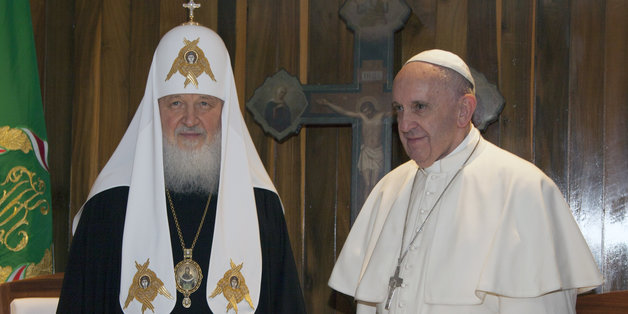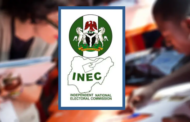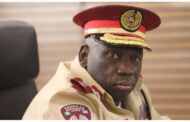For the first time in history, the leader of the Roman Catholic Church met with the head of the largest branch of Eastern Orthodoxy.
The encounter between Pope Francis and Patriarch Kirill, of the Russian OrthodoxChurch, was a symbolic step towards healing a nearly 1,000-year-old schism within Christianity — but the full effects that this meeting will have on the relations between the two churches remain to be seen.
The two religious leaders kissed each other three times on the cheek at José Martí International Airport in Havana, Cuba on Friday.
“Finally!” Francis exclaimed as they embraced, the AP reported. “We are brothers.”
Kirill told the pope through an interpreter: “Now things are easier.”
Their private meeting lasted for three hours. Afterwards, Francis and Kirill were expected to deliver a joint statement in Russian and Italian.
If you’re a history buff, you already know just how huge this meeting is. For the rest who are wondering why this meeting was centuries in the making, we’ve put together a little background.
What’s the difference between Catholics and Eastern Orthodox Christians?
The split between these two Christian traditions has a long and fascinating history. Both churches claim that they can trace their history back in an unbroken line straight to Jesus and his Twelve Apostles. As a result, both assert that they are the one, true original church founded by Jesus during his time on earth.
During the first few centuries of Christianity, politically significant cities (like Rome, Alexandria, Antioch, and Constantinople) each had their own bishop. By the 11th century, the Roman popes had started to claim prominence.
The Western branch of the church believed that the Bishop of Rome was the successor to St. Peter, one of Jesus’ disciples, who had been martyred in Rome. As such, the Roman bishop was thought to have authority over other bishops.
That and other theological and political differences resulted in the Great Schism of 1054, which ultimately led to the division of the Eastern Christian churches and the Western church.
But that’s all ancient history. Why haven’t these churches reconciled yet?
There are a number of doctrinal differences between the churches that still exist — including everything from whether priests can be married to the very nature of the Trinity.
In particular, the Russian Orthodox and Catholic Churches are divided over the presence of Catholics in Ukraine. The Russian Orthodox church accuses the Catholic church of trying to convert Orthodox Christians in that region.
Attempts at reconciliation have been made throughout the centuries (some as early as 1274). There’s been much progress in recent years. Pope Paul VI met with the ecumenical patriarch in Constantinople back in 1964 and Francis has done the same during his time at the Vatican. But no pope from the Roman Catholic has ever met with a Russian patriarch, who leads the majority of the world’s Orthodox Christians.
What do the churches look like now?
There are about 260 million Eastern Orthodox Christians, a small percentage compared to the more than 1 billion Roman Catholics around the world. While the Catholic church still considers the pope to be its spiritual leader, Eastern Orthodoxy is organized like a federation of 15 local churches of ethnic origin (like the Greek Orthodox Church and the Romanian Orthodox Church). Each of these churches has its own head patriarch.
These churches are led by the ecumenical patriarch of Constantinople, Bartholomew I. But that patriarch considers himself to be the “first among equals,” and doesn’t officially hold any special authority over the others.
Still, the Russian Orthodox church is the largest, wealthiest and most powerful branch of Eastern Orthodoxy, with approximately 165 million followers. During his time at the helm, Kirill has pursued closer ties with Russian President Vladimir Putin and the Kremlin.
Why is a meeting happening now?
When the meeting was announced by both churches last week, it took experts by surprise. But it should be noted that this encounter has been years in the making. About 20 years ago, the churches tried and failed to arranged a meeting between Pope John Paul II and the Russian Patriarch Alexy II. Friday’s meeting between Francis and Kirill reportedly took two years to plan.
Ostensibly, Pope Francis and Russian Kirill met in order to call attention to the persecution of Christians by militants in the Middle East, North and Central Africa, and other regions of the world.
According to senior Orthodox cleric Metropolitan Hilarion, the situation demands “urgent measures,” despite the church’s long-standing differences.
“We need to put aside internal disagreements at this tragic time and join efforts to save Christians in the regions where they are subject to the most atrocious persecution,” Hilarion told Reuters.
But the meeting could also be a matter of having the right men in place at the right time.
Both churches have found themselves in the position of having to defend their conservative doctrine and values against the rising tide of secularism.
“Despite their differences, the Russian Orthodox church sees its closest ally in Catholicism now,” Sergei Filatov, a religion expert at the Russian Academy of Sciences in Moscow, told NBC.
Some experts suggest that this was an opportune moment for the Russian church in particular. It allows Kirill to demonstrate his influence ahead of a June conference that will bring together the world’s Orthodox churches. Observers inside Russia alsopoint out that the meeting could open up a new avenue of communication for the Kremlin, at a time when Russia is becoming increasingly becoming isolated from the West because of its military actions in Syria and Ukraine.
“This isn’t benevolence. It’s not a newfound desire for Christian unity,” said George Demacopoulos, the Greek-Orthodox chairman of Orthodox Christian studies at Fordham University in New York told the AP. “It is almost entirely about (Kirill) posturing and trying to present himself as the leader of Orthodoxy.”
Representatives for the Russian church have denied both claims.
Lastly, it could be a simple matter of logistics. Both Francis and Kirill happened to be visiting Latin America at the same time, which created an opportunity to meet in a neutral location.
Why Cuba, of all places?
Cuba is actually quite a strategic location for this first meeting. One big plus is that it is neutral territory. It’s an ocean away from Europe, where both churches have hadterritorial disputes in the past. It is also a country that had historical ties to Russia during the Cold War.
The choice also highlights Francis’ skills as a diplomat. Last year, the pope was credited with playing a crucial role in re-opening formal relations between Washington and Havana.

















